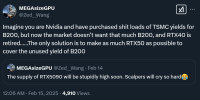Causation is reversed, they have low margins because they compete with each other.
It's generally the case for low end hardwares, and that's why most AIB partners are more focused on high end cards, because they are more likely to have higher margins.
For example, on lower end cards such as 3060, the variation of prices between models is smaller, generally something like 10%. However, on a higher end cards such as 4080 or even 4090, you'll see some crazy OC models which are maybe 20% more expensive than other "simple" models. The reason for that is generally when people are buying lower end products they tend to choose the cheaper ones, while when buying higher end products they are more willing to pay more for the bell and whistles.
So there's really no reason for NVIDIA to artificially restrict supply of higher end cards because they are afraid of AIB partners undercutting each other, because they don't want to do that with higher end products. This is especially true this time, because in the past it could be argued that it takes time for existing inventories of last generation products to get cleared, but this time it's already done (it's hard to find any new 4080 or 4090 on the market already).
I'm not saying the supply is not bad. The retailer I mentioned in the first post, only had 28 5090 on the first day (which got sold out, of course), then it's nothing to this day. They sold way more 5080 (419 according to them) but also nothing later. But to say this is because of artificial restriction, I think we need more evidence (right now there's apparently none, only "because it's possible"). There are more other possiblities, such as the rumors last year about some production problems of AI chips eating more wafer allocation, or they really need to fill the AI chip demands so consumer GPU got sacrificed, or maybe it's not the chip but the assemblies of the cards, etc.


